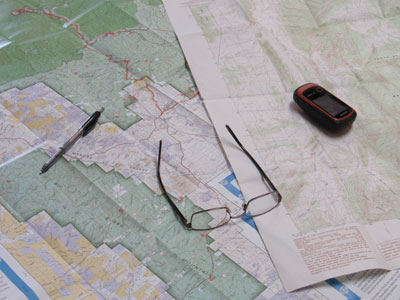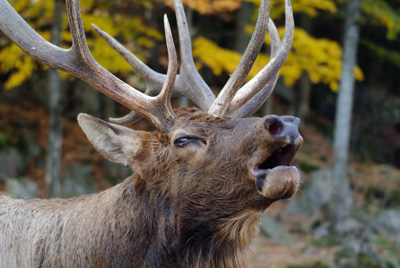Hunting Public Land
Elk hunting public land can be a very rewarding experience. The western United States has large amounts of public land that are prime habitat for elk. These public lands are what make it possible for the average person to afford to hunt elk. Many private lands are only accessible for a fee, or if you have hired an outfitter. But with a little bit of homework, it’s very possible to have a high quality elk hunting experience on public land without breaking the bank. Once you have completed your research, and determined the general area where you are going to hunt, then it’s time to develop the strategy.

Develop a Strategy
You can begin without ever leaving home. The best place to start is with a map of the hunt area. If you are hunting in National Forest you can purchase a map at online map store. Forest Service maps are typically high level and show the major roads and features of the area. This will allow you to determine the best way to enter your hunt area, and possible camping locations. These maps also show boundaries with private property and other public lands. Get familiar with the rules and regulations for the National Forest you will be visiting. These can change by region and jurisdiction.
Once you have determined the general area you plan to hunt, it’s time to get more specific. The best way to do this is with the combination of a topographical map and google earth. A 7.5 minute (1:24,000 scale) map from the USGS (United States Geological Survey) online store is the standard to provide a detailed representation of the terrain. The contour lines will show you ridges and valleys, and will give an indication if a slope is steep or gentle. These maps may also show roads that are not on the National Forest map and indicate wooded and open areas. Google earth will provide you with a virtual fly over of the area and allow you to see features not seen on the map.
How do you go about developing a strategy for elk hunting public land? You are looking for features in the terrain that have the potential to meet an elk’s basic needs: food, water, and shelter.
Food
Elk are grazing animals and typically feed in open meadows. Look for small to medium sized meadows that are located away from major roads and camping areas. Areas that have seen a forest fire or have been logged in the last 20 years can provide a prime feeding area.
Water
Much of elk country is relatively dry. Finding a good source of water near the feeding area can often be the ticket to finding elk. However, the lack of a water source on the map is not a show stopper. Some springs, seeps and natural “tanks” in canyons won’t appear on the map, but the elk know where all of them are.
Shelter
Shelter for an elk is typically a thickly forested area high on a steep slope that is most often north facing. This is where he will establish a bedding area to snooze during the day. Unless disturbed, elk may return to the same bedding area for many days.
When elk hunting public land, finding an area that meets an elk’s needs is a good first step in developing your strategy.
Research Online
Another good way to get the information you need is to ask for elk hunting tips for your specific area in online forums. Hunters that frequent these virtual discussions may not give you the location of their “Honey Hole”, but may be able to give you more up to date information than you have been able to glean from other sources.
Also, there are online membership sites that provide area specific hunting information for a fee.
When you have done all you can from home it’s time to put boots on the ground. It will be best if you can plan a scouting trip to get familiar with the area before the hunt. If that is not possible, plan to arrive early to develop a more detailed strategy before your hunt starts.
Scouting
The purpose of scouting is to get more familiar with the area and look for signs of elk. Explore the area looking for old roads and trails that will provide access to locations where elk may be traveling between bedding, feeding and watering areas. These roads and trails may also be important in packing out an elk after the kill. Be sure to mark them on your GPS and/or your maps.
Look for fresh elk tracks, elk scat, and rubs. Also look for wallows, either wet or dry. A wet wallow is usually just a large mud puddle that the elk rolls in. A dry wallow is also a place where a bull elk will roll, but as the name indicates it is not wet. It is often a dusty or sandy spot where the bull has loosened the ground with his antlers.
Keep your ears open and listen for elk, especially during early morning and evening. Bulls bugle before, during and after the rut and cows communicate with each other regularly.
If you see elk while scouting, resist the urge to approach them for a better look. You don’t want to spook the elk out of the country before you have a chance to hunt them.
Based on the results of your scouting, it’s time to determine the final details of your strategy. What type of hunting method will you use? There are two primary elk hunting methods: stalking and ambush. Will you be looking and listening for elk then planning a stalk? Or will you be planning to ambush an elk from a tree stand or a blind? Your best bet may be to be prepared for both.
If you are going to stalk an elk, be sure to take a look at the Elk Hunting Tips page on this site.
Tree Stands and Blinds
If you will be hunting from a tree stand or a blind, before the season begins is the time to put that in place. Be sure to place your blind downwind, taking into account the prevailing wind direction. Blinds should be placed at a distance that provides a comfortable shot. Obviously this can and should be a longer distance for a rifle or muzzleloader hunter than for an archery hunter.
A tree stand or blind over water can be effective if water is scarce in the area. Other possibilities for blind location include near heavily used trails between bedding and feeding areas, in saddles, near fence crossings, or over a wallow.
A commercial portable blind may be a good option, but even though it is made from camouflage printed material, it needs to be as hidden as possible. Otherwise, elk will see it as a foreign object and may completely avoid the area. Tuck it into existing trees or brush and cover it with limbs. Another option is to build a ground blind with natural materials available in the area.
The scouting never stops even after the hunt begins. Always be on the lookout for signs of elk that will help you to adjust your strategy and tactics throughout the hunt. Be flexible and don’t lock yourself into any specific location or hunting method. While elk tend to follow general routines, they aren’t as habitual as whitetail deer. Hunting pressure, weather, and activity of other elk can all impact an elk’s regular pattern. Be ready to modify your own behavior to locate them again.
Avoid Other Hunters
One of the biggest concerns with elk hunting public land is the possibility of encountering other hunters in the same area. If you come prepared, you’ll be a step ahead of the competition.
Work Your Plan
If you took the time to develop plan and a strategy, you’ll have a good idea of where the elk are, and where they aren’t. Other hunters are probably making up their plan as they go along.
Use your feet
Many hunters will be driving around hoping that an elk will cross the road in front of them. Hunt by hiking away from the roads, and you’ll find that encountering another hunter in the woods will be rare.
Camp Remotely
We all want to camp as comfortably as possible. For many hunters, that will mean camping in an RV park, or a developed campsite. Often, elk hunting public land will provide the opportunity to drive a little farther, on a rougher road, to find a more remote place to camp. This can put the starting point for your hunt each day far away from the majority of other hunters. Remote camping can provide access to areas other hunters will never see.
Stay Mobile
There may be times when hunting public land that you may need to pack up and move your camp to a totally different part of the hunting area. This may be driven by a scarcity of animals or an abundance of other hunters. Whatever the reason, it may pay to be prepared to quickly pack and move on.
Have a Backup Plan
Sometimes, despite all of your planning and efforts, another hunter will reach your planned destination before you. That’s why it’s always best to have a backup location in mind in case something prevents you from hunting as planned.
Developing a strategy, scouting, and avoiding interference from other hunters are all important when it comes to a positive experience when elk hunting on public land. The money you save from a do-it-yourself hunt may allow you to return and hunt following years. The more familiar you are with a given area, the more likely you will locate elk more quickly.

